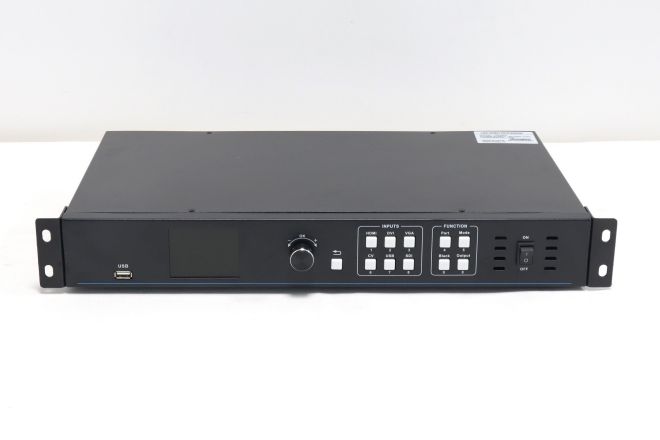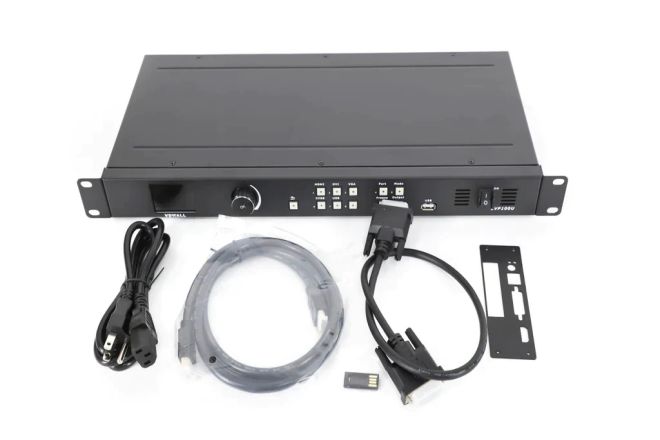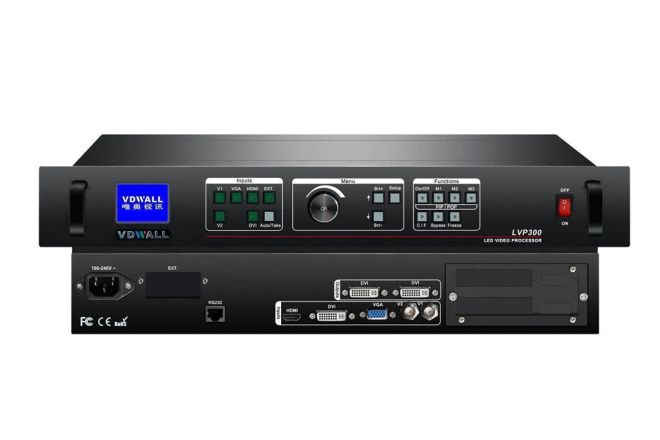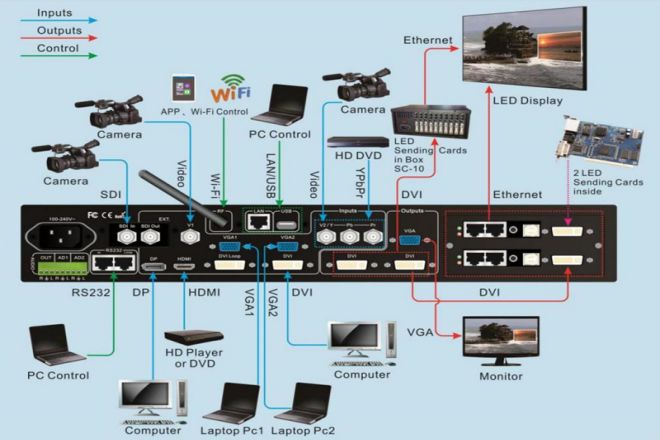Introduction

With the widespread application of LED displays, how to play high-quality videos or pictures has become a key issue. The answer lies in the video processor of the LED display. This device is crucial for every LED display.
So, how do you use the video processor of an LED display screen correctly? This is the core content of this article. Let’s take a look.
1. Introduction to LED display video processor
LED display video processor, also known as picture processor, image converter, video controller, or image processor, is a high-performance image processing and control device specially designed for full-color LED displays.
It can turn video signals from computers, TVs, players, and other devices into signals that can be recognized by LED displays, just like a translator to help them “communicate.”
The main function of the LED display video processor is to convert image signals from external devices (such as Blu-ray DVDs, computers, high-definition playback boxes, etc.) into signals that the LED display can accept and to perform certain optimization processing of the video images. Make the picture displayed on the LED screen clearer and smoother.
In addition to converting signals, it can also adjust the brightness, color, etc., of the video to make the picture look more comfortable. If the size of the video does not match the LED display, it can also enlarge or reduce the video so that the entire screen can display the video content.
Since the display mode of the LED display is point-to-point, this determines that the LED display can only display images consistent with its own physical resolution size.
Because the LED display has a wide color range, but many videos have a narrow color range, the video processor also needs to adjust the color so that the LED display can display the true color of the video.
2. The working principle of LED display video processor

The working principle of the LED display video processor can be briefly summarized in the following steps:
- Signal reception:
The video processor first receives video signals from various signal sources (such as computers, TVs, players, etc.).
- Resolution conversion:
Due to the modular display characteristics of the LED display, its resolution can be very flexible, while the resolution of the video signal may vary. An important task of the video processor is to convert these video signals of different resolutions into a physical resolution acceptable to the LED display.
This usually involves scaling the image, either increasing or decreasing the resolution, to ensure the full image is displayed on the LED display.
- Color space conversion:
The color gamut of LED displays (that is, the range of colors that can be displayed) is usually wider than that of general video signals. Therefore, the video processor also needs to convert the color space of the video signal into a color space that the LED display can accurately display to ensure the accuracy and vividness of the color.
- Image optimization:
The video processor will also perform a series of optimization processes on the image, such as increasing contrast, adjusting brightness, enhancing color, etc., to further improve the quality and visual effects of the image.
- Output display:
After the above processing, the video processor outputs the optimized video signal to the LED display, and the LED display converts the video signal into a light signal for display.
3. Features of LED display video processor
The LED display video processor has many special functions, making it useful in different situations.
- Picture scaling:
Since the display mode of the LED display is point-to-point, it can only display pictures consistent with its own physical resolution size. However, the video processor can scale the image and output the picture to any size to adapt to LED displays with different resolutions.
Sometimes, the size of our video may be different from that of the LED display. At this time, the video processor can enlarge or reduce the image so that it can be displayed just right on the screen.
- Signal conversion and switching:
The video processor can complete format conversion between many signals, such as HDMI, VGA, DVI, etc. In addition, when multiple signals are connected, the video processor can flexibly switch between signals quickly, making the display content more diverse.
For example, sometimes we use a computer, mobile phone, or TV to connect a display screen, and their signals may be different. The video processor can turn these different signals into signals that the LED display can understand so that they can be displayed normally on the screen.
- Image quality improvement:
The video processor can use advanced algorithms to modify image quality, such as deinterlacing, edge sharpening, motion compensation, etc., thereby enhancing image details and improving picture quality. This is especially important for LED displays, as their pixel spacing is often large, which can easily lead to blurred or distorted images.
- Large-screen splicing:
As the size of LED displays becomes larger and larger, video processors need to have splicing functions that can drive large-resolution screens. This not only enables ultra-large screen display but also improves the display effect and cost performance.
- Multi-picture processing:
In some special scenarios, such as billboards, conference rooms, etc., the display screen may need to display multiple pictures of the same or different signals at the same time. The multi-picture processing function of the video processor can meet this demand, allowing multiple pictures to be displayed clearly on the LED display screen at the same time.
For example, if you have a large LED display, the video processor can also help you put together several small screens into one large screen so that you can display a larger picture. Moreover, it can display multiple images at the same time, such as playing several different advertisements on a billboard.
- Interactive technology:
Some advanced LED screen scanning machines also use interactive technology, such as customized touch screens, cloud technology broadcast control management, etc., thereby enhancing the interaction between advertising media and advertising audiences.

4. The core technology of LED display video processor
The core technology of LED display video processors mainly includes the following aspects:
- High-precision full grayscale brightness and chromaticity correction technology:
This technology ensures that the LED display can present accurate color and brightness in various environments. Whether indoors or outdoors, whether in strong light or dark light environments, LED displays can maintain color accuracy and brightness suitability through this technology.
- Fine-pitch LED display image quality engine technology:
Fine-pitch LED displays have higher requirements for image quality because of their small pixel pitch. This technology can significantly improve the image quality of fine-pitch LED displays, making the images more delicate and clear.
- High synchronization video processing technology:
This technology supports multi-layer and multi-screen management, enabling synchronous display of content between multiple screens. Whether it is a large billboard or a multi-screen splicing in a conference room, this technology can ensure the synchronization and consistency of the content displayed on each screen.
- Intelligent image color processing and super-resolution reconstruction technology:
This technology conforms to the visual characteristics of the human eye and can make image colors more realistic and natural. At the same time, it can also improve the resolution of the image through super-resolution reconstruction technology, making the picture clearer.
- High-precision intelligent fault identification technology for display clusters:
This technology can quickly and accurately identify and repair display faults, ensuring the stability and reliability of LED displays. Whether there are problems such as dead pixels, bright lines, or color distortion, this technology can detect and deal with them in time to ensure the normal operation of the display.
5. How to use it?

Connect the device: First, connect various signal sources (such as computers, TVs, players, etc.) to the LED video processor through appropriate interfaces. Make sure all interfaces are connected correctly and the device is transmitting signals properly.
Set the input: In the video processor, you need to set the input source. This usually involves choosing the correct input interface and signal format. Make sure to select input settings that match your source.
Adjust display parameters: According to the specific specifications and needs of the LED display, adjust the display parameters, such as resolution, refresh rate, brightness, contrast, etc. The settings of these parameters will affect the display effect of the display.
Multi-picture processing: If you need to display multiple pictures at the same time, you can use the multi-picture processing function of the video processor. This usually involves displaying multiple input signals on the screen simultaneously and adjusting their position and size.
Color correction: For a more accurate color display, you can use the color correction feature of your video processor. This usually involves adjusting the values of the RGB color channels to ensure color accuracy and consistency.
Startup and debugging: After completing the above settings, start the video processor and observe the display effect of the display. If necessary, further debugging and optimization can be performed to obtain the best display effect.
6. About the selection of LED display video processor brand
Among the brands of LED display processors, the best ones are, of course, Nova’s processors.
Of course, RGBSKY, Linsn Technology, KYSTAR, AVSOLUTIOMYECH brands are also known as video processor products, each with its own characteristics and advantages.
Therefore, you need to consider the application requirements when making a selection to choose a video processor with the necessary functions. For example, if you need to process high-definition video signals, you should choose a video processor that supports high-definition input and output.
In addition, a brand after-sales guarantee is also very important, which will save you a lot of unnecessary trouble in the future.
Conclusion
The above is all the knowledge about LED display video processors. If you want to know more about LED displays, please get in touch with us!
